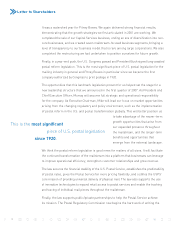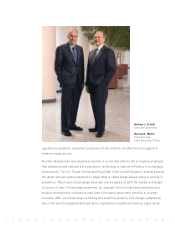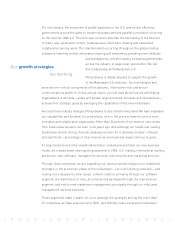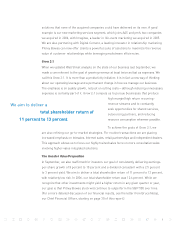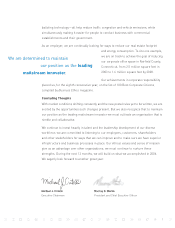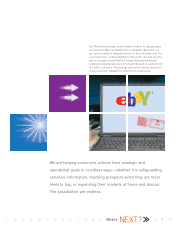Pitney Bowes 2006 Annual Report Download - page 4
Download and view the complete annual report
Please find page 4 of the 2006 Pitney Bowes annual report below. You can navigate through the pages in the report by either clicking on the pages listed below, or by using the keyword search tool below to find specific information within the annual report.
2
It was a watershed year for Pitney Bowes. We again delivered strong financial results,
demonstrating that the growth strategies we first articulated in 2001 are working. We
completed the sale of our Capital Services business, ending an era of diversification into non-
core businesses, and we created seven mailstream-focused business segments, bringing a
level of transparency to our business model that is rare among large corporations. We also
completed the restructuring we had undertaken to position ourselves for future growth.
Finally, in a year-end push, the U.S. Congress passed and President Bush signed long-awaited
postal reform legislation. This is the most significant piece of U.S. postal legislation for the
mailing industry in general and Pitney Bowes in particular since we became the first
company authorized by Congress to print postage in 1920.
The opportunities that this landmark legislation present for us helped set the stage for a
new leadership structure that we announced in the first quarter of 2007. As President and
Chief Executive Officer, Murray will assume full strategic and operational responsibility
for the company. As Executive Chairman, Mike will lead our focus on market opportunities
arising from the changing regulatory and policy environment, such as the implementation
of postal reform in the U.S. and postal transformation globally. This will better position us
to take advantage of the nearer-term
growth opportunities that arise from
our expanded presence throughout
the mailstream, and the longer-term
benefits and opportunities that
emerge from the external landscape.
We think the postal reform legislation is good news for mailers of all sizes. It will facilitate
the continued transformation of the mailstream into a platform that businesses can leverage
to improve operational efficiency, strengthen customer relationships and grow revenue.
The law secures the financial stability of the U.S. Postal Service, establishes the predictability
of postal rates, gives the Postal Service far more pricing flexibility, and codifies the USPS’
core mission of providing universal delivery of physical mail. The law also supports the use
of innovative technologies to expand retail access to postal services and enable the tracking
and tracing of individual mail pieces throughout the mailstream.
Finally, the law supports public/private partnerships to help the Postal Service achieve
its mission. The Postal Regulatory Commission now begins the hard work of writing the
Letter to Shareholders
This is the most significant
piece of U.S. postal legislation
since 1920.




